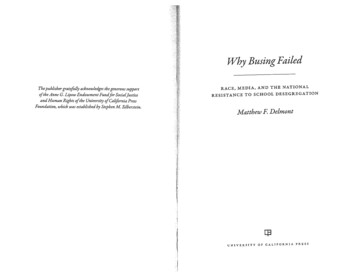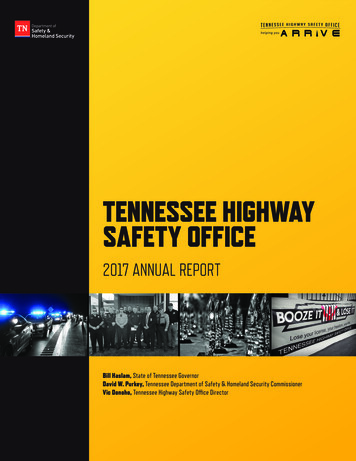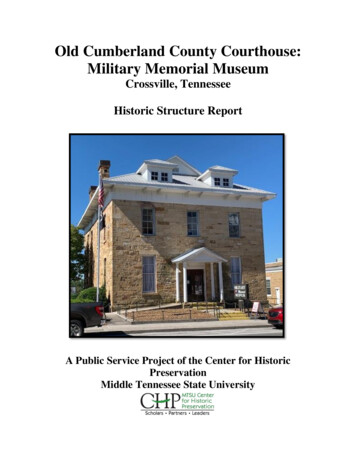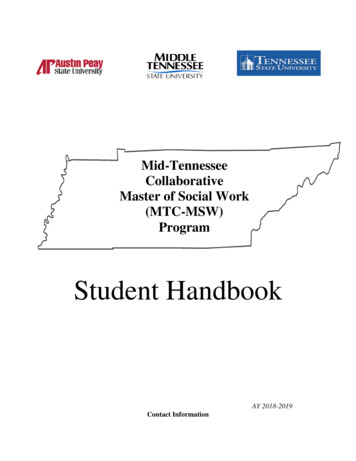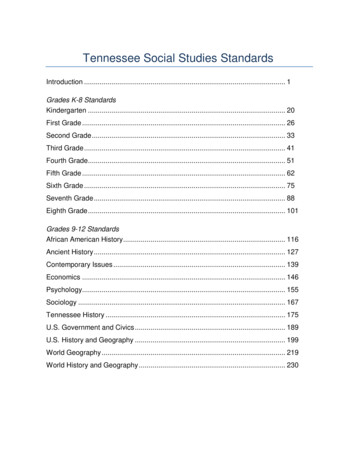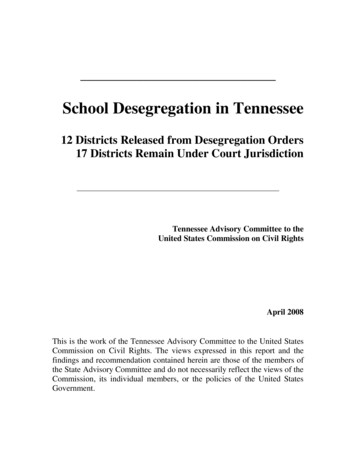
Transcription
School Desegregation in Tennessee12 Districts Released from Desegregation Orders17 Districts Remain Under Court JurisdictionTennessee Advisory Committee to theUnited States Commission on Civil RightsApril 2008This is the work of the Tennessee Advisory Committee to the United StatesCommission on Civil Rights. The views expressed in this report and thefindings and recommendation contained herein are those of the members ofthe State Advisory Committee and do not necessarily reflect the views of theCommission, its individual members, or the policies of the United StatesGovernment.
The United States Commission on Civil RightsThe U.S. Commission on Civil Rights is an independent, bipartisan agency established byCongress in 1957, reconstituted in 1983, and reauthorized in 1994. It is directed toinvestigate complaints alleging that citizens are being deprived of their right to vote byreason of their race, color, religion, sex, age, disability, or national origin, or by reason offraudulent practices; study and collect information relating to discrimination or a denialof equal protection of the laws under the Constitution because of race, color, religion,sex, age, disability, or national origin, or in the administration of justice; appraise federallaws and policies with respect to discrimination or denial of equal protection of the lawsbecause of race, color, religion, sex, age, disability, or national origin, or in theadministration of justice; serve as a national clearinghouse for information in respect todiscrimination or denial of equal protection of the laws because of race, color, religion,sex, age, disability, or national origin; submit reports, findings, and recommendations tothe President and Congress; and issue public service announcements to discouragediscrimination or denial of equal protection of the laws.The State Advisory CommitteesBy law, the U.S. Commission on Civil Rights has established an advisory committee ineach of the 50 states and the District of Columbia. The committees are composed of statecitizens who serve without compensation. The committees advise the Commission ofcivil rights issues in their states that are within the Commission’s jurisdiction. Morespecifically, they are authorized to advise the Commission on matters of their state’sconcern in the preparation of Commission reports to the President and the Congress;receive reports, suggestions, and recommendations from individuals, public officials, andrepresentatives of public and private organizations to committee inquiries; forward adviceand recommendations to the Commission, as requested; and observe any open hearing orconference conducted by the Commission in their states.ii
Letter of TransmittalTennessee Advisory Committee to theU.S. Commission on Civil RightsMembers of the Commission:Gerald A. Reynolds, ChairmanAbigail Thernstrom, Vice ChairpersonTodd GazianoGail I. HeriotPeter N. KirsanowArlan D. MelendezAshley L. Taylor, Jr.Michael YakiThe Tennessee Advisory Committee (Committee) submits this report, SchoolDesegregation in Tennessee: 12 Districts Released from Desegregation Orders, 17Districts Remain Under Court Jurisdiction, as part of its responsibility to study pressingcivil rights issues in the State and report on its findings. The report was unanimouslyapproved by the members of the Tennessee Advisory Committee at a meeting of theCommittee by a vote of 10 yes, 0 no, and no abstentions.In support of a national Commission study on school desegregation, this reportprovides both to the Commission and the public a complete assessment of the schooldesegregation status of the 136 public school districts in Tennessee. It identifies allschool districts in the state ever subject to a school desegregation court order and thoseschool districts that have been declared by the court to have “unitary status.” TheSupreme Court established the term “unitary status” to describe a school system that hasmade the transition from a segregated or ‘racially dual’ system to a desegregated or‘unitary’ system.To that purpose, we report that of the 136 public school districts in Tennessee, 29have been subjected to litigation in the federal courts to desegregate public schools.Eleven (11) of those districts have had school desegregation litigation against the districtdismissed and have been released from further court jurisdiction. Eighteen (18) schooliii
districts remain under a school desegregation court order. Of those districts that arepresently under court jurisdiction, only five are either actively pursuing unitary status orconsidering pursuing “unitary status” in the future. Although presented for informationpurposes in the appendix, we did not examine trends in private school enrollment andoffer no opinion and make no findings on the motivations of parents who choose to sendtheir children to private school.We endorse and support school integration as a desirable social goal and supportthe pursuit of all legal efforts to allow for full integration of the schools. This report isonly intended as a fact-finding with respect to the school desegregation status of theschool districts in the state, and no inference from this document should be drawn aboutthe efficacy or effect of “unitary status” on school integration patterns. Nevertheless,given the long and sad history of racial segregation in the state’s public schools and thenecessity for court intervention in some school districts, the courts, school boards, electedofficials, and communities should remain vigilant regarding school integration and workto consider all lawful and prudent measures to encourage integration in the public schoolsystem.Respectfully,Rev. Bernie Miller, ChairmanTennessee State Advisory Committeeiv
Tennessee Advisory Committee to theU.S. Commission on Civil Rights*Rev. Bernie Miller, ChairmanChattanoogaMs. Tiffany B. Cox, Esq.NashvilleMs. Amber Darcy GoodingNashvilleMr. Gregory Grisham, Esq.MemphisMs. Dorothy Day JonesMemphisDr. Vicki LottJacksonDr. Carol M. SwainNashvilleMr. Eliud Gonzalez TrevinoNashvilleMs. Susan J. WilliamsNew MarketMr. Tom Edd WilsonChattanooga* Josh L. Thomas, Memphis, TN, was a member of the Tennessee Advisory Committeeat the initiation of the school desegregation project, but resigned from the Committeeprior to final adoption of the report. All 10 remaining members of the Tennessee StateAdvisory Committee voted, and all 10 members approved the report. It is a unanimousreporting by the Tennessee State Advisory Committee, all members participating.v
Contributors and U.S. Commission ContactUSCCR ContactPeter Minarik, Ph.D.Regional DirectorSouthern Regional OfficeU.S. Commission on Civil Rights(404) 562-7000 or pminarik@usccr.govRev. Bernie MillerChairmanTennessee Advisory Committee(423) 899-8001 or RevBMiller@aol.comContributors—In addition to the persons named above, the following individuals madeimportant contributions to this report. Monica Aitzu and Monique Rainey did backgroundresearch and assisted in the writing of the report.This report can be obtained in print form or on disk in Word format from the Southern Regional Office,U.S. Commission on Civil Rights, by contacting the above named Commission contact person. It is alsoposted on the web-site of the Commission at www.usccr.gov.vi
ContentsBackground1History of Legalized Segregation in Tennessee1U.S. Supreme Court Disallows Racial Segregation in Schools,Establishes Concept of Unitary Status in Green Decision3Twenty-Nine (29) School Districts in TennesseeSued to Desegregate Schools612 School Districts in TennesseeHave Unitary Status8Listing of Individual School Districts917 School Districts Remain Under a Court Order19U.S. Department of Justice Is a Party to Eleven (11)Active School Desegregation Lawsuits19Private Desegregation Lawsuits Still OpenAgainst Six Public School Districts25Findings and Recommendation30Appendix I—Public School Districts in Tennessee and Desegregation Status31Appendix II—Private School Enrollment in Four LargestCounties of Tennessee34Appendix II—Public School District Comments39vii
TablesTable 1: School Districts in Tennessee Sued to Desegregate Schools7Table 2: School Districts in Tennessee with Unitary Status andYear of Dismissal9Table 3: Open School Desegregation Cases in Tennessee to WhichU.S. Department of Justice is a Party20Table 4: Active School Desegregation Cases in Tennessee Filed byPrivate Parties26FiguresFigure 1: Public School Enrollment and Private School Enrollment ofWhite School-Age Children in Davidson County35Figure 2: Public School Enrollment and Private School Enrollment ofWhite School-Age Children in Hamilton County36Figure 3: Public School Enrollment and Private School Enrollment ofWhite School-Age Children in Knox County37Figure 4: Public School Enrollment and Private School Enrollment ofWhite School-Age Children in Shelby County38viii
BackgroundFollowing the Civil War, Tennessee, a former slave state, enacted a series ofstatutes that mandated racial segregation in most areas of public life, includingtransportation, public accommodation, and education. In 1896, the U.S. Supreme Courtissued its Plessy decision that established the legal precedent of separate but equalfacilities for blacks and whites. In 1954 the Court in Brown versus Board of Educationoverturned the Plessy decision, and 29 school districts in Tennessee were sued to forciblyintegrate their schools.History of Legalized RacialSegregation In TennesseeTennessee has a long history of racial segregation. A former slave state, followingthe Civil War and continuing into the 1950s Tennessee enacted a series of statutes thatlegalized racial segregation. These laws mandated a de jure segregation of the races inmany parts of social and community life to include marriage and cohabitation, differentmodes of public transportation, and public accommodation.In 1870 the state Constitution was amended to prohibit interracial marriage. Theforce of the amendment was strengthened in the same year by the passage of a separatestatute that imposed prison time on those who intermarried racially. In 1875 a statestatute directed at limiting public accommodation gave specific rights to hotel keepers,carriers of passengers, and keepers of places of amusement to exclude any person theproprietor desired. By a statute enacted in 1881, railroad companies were specificallyrequired to furnish separate cars for “colored” passengers. In 1885 the state again gaveproprietors of theaters, parks, shows, and other public amusements the right to createseparate accommodations for whites and blacks. In 1905 with the coming of theautomobile age, all street cars were required to designate a portion of each car for whiteand “colored” passengers. In 1932, the State Code was amended to classify as “Negro”any person with any “Negro” blood. In 1955 the State Code was modified four times toenforce racial segregation. The new Code ordered all public carriers to be segregated andrequired separate washrooms in mines and separate buildings for black and white patients1
in mental institutions. In addition, the amended Code expanded the miscegenation laws toprohibit racially mixed couples living together as man and wife.1In addition to these areas, another set of state laws proscribed integration in thestate’s public schools. The first school segregation act was passed in 1866, one yearfollowing the end of the Civil War. The segregation education act required separateschool systems for white and black children.2 Four years later in 1869, the stateconstitution was amended and under article XI racial integration in all schools in the statewas barred.3 However, article XI did grant all citizens of the state, regardless of color, theright to attend the University of Tennessee, though the law ordered that the instructionalfacilities at the university for colored students were to be separate from those used bywhite students.Beginning in 1870 a series of education statutes reinforced a dual school systemthroughout the state. In 1870 the state enacted an education provision that ordered theschools for white and “colored” children are to be kept separate.4 This was followed in1873 by legislation that mandated the management and operating standards for both racesto be similar, however the education of children in the state were still to be done inseparate facilities, i.e., “white and colored persons shall not be taught in the same school,but in separate schools under the same general regulations as to management, usefulness,and efficiency.”5 In 1901, the state legislature passed a statute that made it an offensepunishable by a fine of 50 or imprisonment from 30 to 60 days or both for any school orcollege to educate students in an integrated school.6 Another education statute waspassed in 1925 that mandated that separate elementary and high schools are to be1Jim Crow Laws: Tennessee at ded south.cgi (lastreferenced July 20, khistory/timelines/timeline 1866-1870.html (last accessedAug. 12, ow/insidesouth.sgi?state Tennessee (last accessed Aug. 12,2007).4Pamela B. Walters, “Citizenship and Public Schools: Accounting for Racial Inequality in Education inThe Pre- and Post-Disenfranchisement South,” American Sociological Review, February 1997, pp. 34-52.5Charles Magnum, The Legal Status of a Negro (Knoxville: XX, 1875), Chapter 130, no. tion2/educat.pdf (last accessed Aug. 12, 2007).2
maintained for white and Negro children,7 and this was followed by a similar act in 1932that required racially segregated high schools.8As the dual school system worked to retard equal educational opportunities in thestate, different private groups organized education programs for black adults andchildren. Prominent among these were so-called ‘Citizenship Schools.’ Designed to teachblacks to read and write so they could register to vote, they were originally organizedbetween 1953 and 1961 by the Highlander Folk School in Monteagle, Tennessee. Thoughfirst established in 1932 to serve oppressed white workers in the Appalachian Mountains,the Highlander School turned its attention to civil rights in the early 1950s and educatedmany individuals who would later become prominent in the civil rights struggle. Theschool’s open defiance of the state’s segregation laws met with retaliation and reprisalfrom the general community. The racially integrated school was first fire-bombed, andlater in 1960 state officials attempted to close the school by padlocking the doors.9U.S. Supreme Court Disallows Racial Segregation in Schools,Establishes Concept of Unitary Status in Green DecisionThe 1896 Plessy decision established the legal precedent that separate but equalfacilities for blacks and whites were constitutional. This precedent would be used in theensuing decades as the legal basis for the establishment of racially segregated schoolsystem in Tennessee and other states in the South. The Plessy decision stemmed from thearrest in 1892 of then 30-year-old Homer Plessy for sitting in the “White” car of the EastLouisiana Railroad. Because he was a creole Plessy could pass for white, but underLouisiana law he was still considered black despite his light complexion and required tosit in the “Colored” car. The case eventually came before the U.S. Supreme Court andPlessy's lawyer argued that the state’s Separate Car Act violated the Thirteenth andFourteenth Amendments to the tions/JIM CROW/LAWS/BY/STATE2004.doc (last accessedAug. 12, 2007).8Raymond Bernard, “Consequences of Racial Segregation,” The American Catholic Sociological Review,June 1949, p. 82.9See inter alia, Mark Bauerlein and others, Civil Rights Chronicle (Lincolnwood, Illinois: LegacyPublishing, 2003), p. 165.10http://www.pbs.org/wnet/jimcrow/stories events plessy.html (last accessed on Sept. 5, 2007).3
In 1896, the Supreme Court of the United States heard the case and held theLouisiana segregation statute constitutional. Speaking for a seven-man majority, JusticeHenry Brown wrote: “A statute which implies merely a legal distinction between thewhite and colored races has no tendency to destroy the legal equality of the two races.The object of the [Fourteenth] Amendment was undoubtedly to enforce the absoluteequality of the two races before the law, but in the nature of things it could not have beenintended to abolish distinctions based upon color, or to enforce social, as distinguishedfrom political equality, or a commingling of the two races upon terms unsatisfactory toeither.”11On May 17, 1954, the U.S. Supreme Court in Brown versus Board of Educationoverturned the Plessy decision and with it a 60-year legacy of racial segregation in theNation’s schools. Speaking for the Court, Chief Justice Warren read the decision of theCourt. “We come then to the question presented: Does segregation of children in publicschools solely on the basis of race, even though the physical facilities and other ‘tangible’factors may be equal, deprive the children of the minority group of equal educationalopportunities? We believe that it does. We conclude that in the field of public educationthe doctrine of 'separate but equal' has no place. Separate educational facilities areinherently unequal.”12The unanimous Brown decision, however, did not immediately end schoolsegregation. The Court’s ruling did not specify how or how quickly desegregation was tobe achieved in the thousands of segregated school systems. Southern states claimed animmediate implementation of the Order was impracticable while the NAACP urgeddesegregation to proceed within firm deadlines. The following year, the case wasreargued on the question of relief and the Court embraced a view close to that of thestates and essentially returned the problem back to the lower courts for appropriatedesegregation relief, albeit with the provision that such efforts should proceed with “alldeliberate speed.”13 By 1964, a decade after the Brown decisions, school segregation wasstill prevalent.Over the course of the next several decades, the Federal government, parents, theNAACP, and other parties would take legal action to ensure compliance with the Brown11Plessy v. Ferguson, 163 U.S. 537 (1896)Brown v. Board of Education, 347 U.S. 493, 495 (1954).13Brown II, 349 U.S. 294, 301 (1955).124
decision by local school districts. In response to such litigation, a common strategyadopted by many formerly segregated school districts to comply with the Brown decisionwere “freedom of choice” plans. In 1968, however, the U.S. Supreme Court in Green v.County School Board of New Kent14 ruled that such attendance plans were ineffective forproducing integration in the schools and mandated that federal courts must to the extentpracticable look not only at student assignment, but to every facet of school operations.These factors have come to be commonly referred to as the Green factors, and include:(1) student assignment, (2) faculty assignment, (3) staff assignment, (4) transportation,(5) extracurricular activities, and (6) facilities. In addition, in the Green decision theSupreme Court established the term unitary status to describe a school system that hasmade the transition from a segregated or ‘racially dual’ system to a desegregated or‘unitary’ system. Under the Green decision, for a school district to receive a declarationof “unitary status” from the courts, the school district was required to present to the courtpersuasive evidence that all vestiges of segregation for each Green factor had beeneliminated and were unlikely to be resurrected.Since the process developed by the courts to determine unitary status and releasedistricts from desegregation orders was a lengthy and often expensive process, a largenumber of school districts remain under court supervision with respect to schooldesegregation decades after dismantling previously “racially dual” school systems andoperating a “unitary” school system.15 As a result, in the early 1990s the U.S. SupremeCourt re-visited the general standards for unitary status in two cases, Board of Educationof Oklahoma City Public Schools v. Dowell16 and Freeman v. Pitts.17In Dowell, the Court re-affirmed its support for its 1968 Green decision, and in sodoing clarified the standard for unitary status by ruling that such a declaration isappropriate after the school district has demonstrated that it has complied with thedesegregation order of the court for a reasonable period of time and demonstrated itsgood faith commitment to the Constitutional rights that predicated the initial judicialintervention. The decision seems to have provided an impetus for a number of school14391 U.S. 430 (1968).Monika Moore, “Unclear Standards Create an Unclear Future: Developing a Better Definition of UnitaryStatus,” 112 Yale L. J. 311 (Nov. 2002).16498 U.S. 237 (1991).17503 U.S. 467 (1992).155
districts previously under court jurisdiction to receive a dismissal of the schooldesegregation court order. In the years following the Dowell decision, dozens of schooldistricts in Tennessee and throughout the South previously under a court order weregranted unitary status by the courts. Of the nine school districts in the state that receivedunitary status after the Green decision, five have had their court orders dismissed after1991.Twenty-Nine (29) School Districts in TennesseeSued to Desegregate SchoolsIn the twenty year period between 1951 to 1971, 43 public school districts inTennessee were sued to desegregate the schools. Since the time of those initiating actionsmany of those school districts have consolidated with other school districts so that todayonly 29 of the state’s presently 136 public school districts (21 percent) were ever subjectto court intervention to integrate the schools. (Table 1 lists the 29 active school districtsin Tennessee ever involved in school desegregation litigation and a complete listing of allschool districts and their desegregation status is in Appendix I.)Among the 29 school districts, the school desegregation cases in 12 districts havebeen dismissed and the school district granted unitary status.18 The United StatesDepartment of Justice (Justice) initiated action to compel school integration in 19 schooldistricts. Of these 19 cases, three school districts no longer exist and cases against fourother districts have been dismissed. Of the twelve remaining districts, two schooldistricts—City of Jackson and Madison County—merged into a consolidated district,with the result that eleven public school districts in the state remain under schooldesegregation litigation to which Justice is a party. Seven school districts have haddesegregation lawsuits initiated against them by private parties that remain open infederal court.18Anderson County and Campbell County had their school desegregation cases dismissed prior to the 1968Green decision and are considered for purposes of this report as having unitary status.6
Table 1: School Districts in Tennessee Sued to Desegregate 272829School DistrictAlamo CityAnderson CountyBells CityCampbell CountyCrockett CountyDyersburg CityFayette CountyFranklin CountyFranklin SpecialGibson CountyHamilton CountyHardeman CountyHaywood CountyHumboldt CityHumphreys CountyJackson-Madison CountyJohnson CityKnox CountyLebanon CityMaury CountyMemphis CityMilan CityMonroe CountyNashville-Davidson CountyObion CountyShelby CountySweetwater CityTipton CountyTrenton OCOCOCOUSUSCOUSCOCOUSUSCOCOCOCONote: CO indicates district remains under a Court Order; US indicates district released from Court Order.Source: Tennessee Advisory Committee, U.S. Commission on Civil Rights.7
12 School Districts in TennesseeHave Unitary StatusOf the presently 29 school districts in the state ever subjected to court jurisdictionto desegregate the public schools, 12 districts have been released from a court order. Thetwelve districts are: (1) Alamo City, (2) Anderson County, (3) Bells City, (4) CampbellCounty, (5) Crockett County, (6) Hamilton County, (7) Haywood County, (8) LebanonCity, (9) Knox County (Knoxville City), (10) Memphis City, (11) Nashville-Davidson,and (12) Obion County. Two of the twelve school districts, Anderson County andCampbell County, had their court orders dismissed prior to the 1968 Green decision. Theother ten districts had their court orders dismissed after the Green decision, and wereformally granted a declaration of unitary status by the court.Prior to the 1991 Dowell decision, six districts were dismissed from courtjurisdiction. Anderson County was the earliest desegregation suit filed in the state, 1950,four years before the Brown decision. Court jurisdiction over the district ended in 1956when the court ruled the district was operating a unitary school district and dismissed theaction. Court jurisdiction over Campbell County was dismissed in 1967, just one yearafter the initiating action. Following the 1968 Green decision, Knoxville City, whichwould subsequently merge with Knox County, was declared in 1974 to have achievedunitary status. Two years later, Lebanon City was dismissed after 10 years under courtjurisdiction. In 1986 Hamilton County received a declaration of unitary status from thecourt, and in 1988 Obion County was granted unitary status after 27 years of courtjurisdiction.Of the six school desegregation cases dismissed after the 1991 Dowell decision,four have been dismissed in the past two years. Haywood County was dismissed in 2006,after 40 years of court jurisdiction, while Alamo City, Bells City, and Crockett Countywere dismissed in 2007 after 41 years of court supervision. The two other districts in thestate to obtain unitary status after the Dowell decision are Memphis City in 1997 andNashville-Davidson County District in 1998.8
Table 2: School Districts in Tennessee with Unitary Status and Year of Dismissal123456789101112School DistrictAlamo CityAnderson CountyBells CityCampbell CountyCrockett CountyHamilton CountyHaywood CountyKnox CountyLebanon CityMemphis CityNashville-DavidsonObion CountyYear 5199719981988Source: Tennessee Advisory Committee to the U.S. Commission on Civil Rights.1. Alamo City School DistrictThe Alamo City School District is located in Crockett County, and about 25percent of the residents of the Alamo are minorities. The case against Alamo City wasfiled by Justice in 1966 and the case initially involved seven school districts. Six of theseven districts, including Alamo City, were municipal districts each operating one allwhite K-12 school. The seventh district, Crockett County, was a county-wide all blackdistrict that operated three K-8 schools. Today, the Alamo City School Districtcorresponds to the original Alamo City District, operates one K-6 elementary school withstudents attending middle and high schools operated by the Crockett County SchoolDistrict.Initiating Case Name:Year of Initiating Case:Current Status:Year of Final Decision:U.S. v. Crockett County Board of Education, et al1966Case Dismissed—Unitary Status20079
2. Anderson CountyAnderson County was the first school district in Tennessee to be sued in federalcourt to end racial segregation in its schools. Anderson County, immediately north ofKnoxville, includes the Oak Ridge community.19 Today the school system operates oneelementary school, and African Americans comprise about 24 percent of total enrollment.The lawsuit was first brought against the school district in 1950 with ThurgoodMarshall as the lead attorney. The court originally found in favor of the school districtand upheld the legality of a segregated school system, but in the wake of the Browndecision rescinded that action moving to retain jurisdiction “for the issuance of suchorders as may hereafter be necessary upon a showing that the school authorities ofAnderson County are not in good faith undertaking compliance with the directorate of theSupreme Court.”20Following Brown, in 1956 the court ordered Anderson County to desegregate, andthe district complied with the Court Order and began to immediately and completelyintegrate the schools in the system. As a result, when 12 African Americans beganattending Clinton High School, the school became the first publicly supported highschool in the South to be desegregated. The event, however, was not without incident asthere was mass picketing by more than 3,000 whites and attacks on the attending blackchildren and guardian adults. The court issued a restraining order, and civil order wasonly restored by more than 600 National Guardsmen using fixed bayonets.21 The courtissued a Final Decree in 1957 effectively closing the case, although jurisdiction wasretained “for purposes of enforcement of this decree, but for no other purpose.”22Initiating Case Name:Year of Initiating Case:Current Status:Year of Final Decision:McSwain et al., v. County Board of Education of AndersonCounty, Tennessee, et al.1950Case Dismissed195619The Oak Ridge facility was developed and built in the 1940s as part of the Manhattan project and thelaboratories at the site produced the enriched uranium for the first atomic bombs.20McSwain et al. v. County Bd. of Educ. of Anderson County, TN, et al., C.A. No. 1555 (E.D. TN, 1954).21See inter alia, Wilson, Samuel, “Desegregation & Remedies,” History of the Sixth Circuit, athttp://www.ca6.uscourts.gov/lib hist/cases/desegregation.htm (last accessed Sep. 1, 2007).22McSwain et al. v. County Bd. of Educ. of Anderson County, TN, et al., C.A. No. 1555 (E.D. TN, 1954).As the case was closed prior to the Green decision, the district received no formal declaration of unitarystatus f
Table 1: School Districts in Tennessee Sued to Desegregate Schools 7 Table 2: School Districts in Tennessee with Unitary Status and Year of Dismissal 9 Table 3: Open School Desegregation Cases in Tennessee to Which U.S. Department of Justice is a Party 20 Table 4: Active School Desegregation Cases in Tennessee Filed by Private Parties 26 Figures


